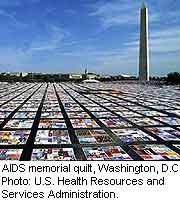
SUNDAY, July 18 (HealthDay News) – Effective and widespread treatment of HIV disease may also help cut the rate of new infections, researchers report.
Since the introduction of powerful anti-HIV drugs known as highly active antiretroviral therapy (HAART) in 1996, the number of new cases of HIV infection in the Canadian province of British Columbia has decreased by more than half, the team report.
The study is published online July 18 in The Lancet in conjunction with its presentation Sunday at the International AIDS Society (IAS) meeting in Vienna.
“Our results show a strong and significant association between increased HAART coverage, reduce community viral load, and decreased number of new HIV diagnoses per year in the population of a Canadian province,” Professor Julio Montaner, director of the British Columbia Centre for Excellence in HIV/AIDS, and his colleagues wrote in a news release issued by the journal.
HAART slows the progression of HIV/AIDS symptoms.
The team analyzed data from the British Columbia Centre for Disease Control and found that between 1996 and 2009, the number of people receiving HAART increased from 837 to 5,413 (547 percent increase) and the number of new HIV diagnoses fell from 702 to 338 per year (52 percent decrease).
For every 100 additional patients on HAART, the number of new HIV cases decreased by 3 percent. There was also a significant decrease in mean HIV viral load concentrations, a trend linked to the decrease in new HIV cases, the researchers said.
New HIV diagnoses fell by 30 percent between 1996 and 2000, declined 2 percent between 2001 and 2003, and fell another 17 percent between 2004 and 2009. Evolving treatment guidelines led to substantial increases in HAART use in 1996-2000 and 2004-09, the study found.
The largest decrease (nearly 50 percent) in new HIV cases between 1996 and 2009 was among injection drug users.
The researchers also found that rates of sexually transmitted diseases and hepatitis C infections increased during the last years of the study, which suggests that the decrease in new HIV cases can’t be attributed to a decrease in risky sexual behaviors associated with HIV transmission.
“Our results support the proposed secondary benefit of HAART used within existing medical guidelines to reduce HIV transmission [and] provide a strong rationale for re-examination of the HIV prevention and treatment dichotomy, as has been strongly advocated by the UN Joint Program on HIV/AIDS (UNAIDS) as part of a comprehensive combination prevention strategy,” the researchers concluded.
This study, as well as previous work by Montaner and his colleagues, have helped shape the new UNAIDS strategy that calls for 15 million HIV patients worldwide to be treated with antiretroviral drugs, instead of the current five million patients. The plan would cost $26 billion a year.
HIV/AIDS experts should take note of the Canadian researchers’ study, two Italian doctors wrote in an accompanying editorial in the journal.
“While waiting for an effective vaccine, experiences such as those reported today should be strongly considered by clinicians, national and international agencies, policy makers, and all parties involved in the development of treatment guidelines, because the population-based dimension of HAART might play an important part in the future control of the HIV epidemic,” wrote Dr. Franco Maggiolo and Dr. Sebastiano Leone, Division of Infectious Diseases, Ospedali Riuniti in Bergamo.
More information
The New Mexico AIDS Education and Training Center has more about antiretroviral therapy.

